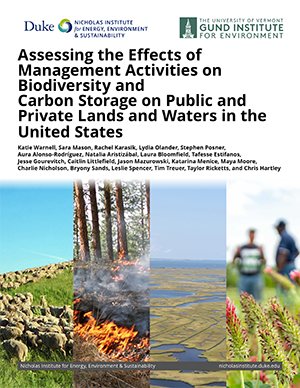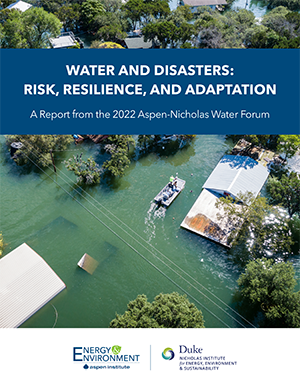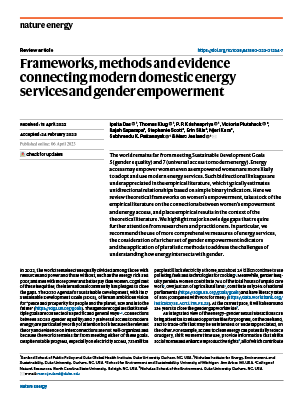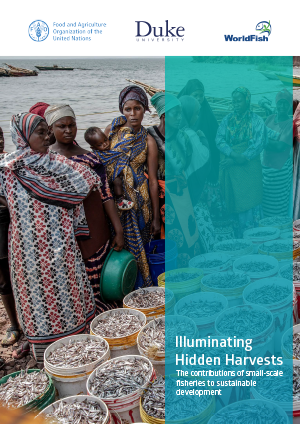Publications
Defining Extreme Heat as a Hazard: A Review of Current State Hazard Mitigation Plans
US states must have a FEMA-approved state hazard mitigation plan (SHMP) to apply for certain nonemergency disaster funds and funding for mitigation projects. SHMPs indentify the hazards that may impact a state and detail corresponding mitigation strategies. This report assesses the treatment and definition of heat as a hazard in each state's most recent plan. The importance of extreme heat—the leading cause of weather-related death in the United States—is often understated because it does not fit easily into current SHMP guidelines. The authors provide recommendations to help states adequately evaluate the threat of extreme heat as they update their SHMPs.
Assessing the Effects of Management Activities on Biodiversity and Carbon Storage on Public and Private Lands and Waters in the United States
Natural and working lands (NWLs) provide many benefits to people, including storing greenhouse gases (GHGs), supporting biodiversity, and generating other ecosystem services. Management of NWLs can influence their condition and function and therefore the benefits they provide. This project surveys the synthesis literature to assess how management actions on various types of NWLs affect biodiversity and GHG outcomes. This information can help to determine how to best manage these lands to contribute to both biodiversity and climate solutions in the United States.
Water and Disasters: Risk, Resilience, and Adaptation
The 2022 Aspen-Nicholas Water Forum explored what must be done to ensure the water sector becomes more resilient to water-related disasters. How can communities navigate and prepare for the impacts of increasingly common water-related disasters. How do we reconcile different values as individuals, businesses, and government negotiate who receives resources to mitigate, adapt, and recover?
Frameworks, Methods and Evidence Connecting Modern Domestic Energy Services and Gender Empowerment
In 2022, the world remained unequally divided among those with resources and power and those without, such as the energy rich and poor, and men with more power and better pay than women. Cognizant of these inequities, the international community has pledged to close the gaps. This review examines theoretical frameworks on women’s empowerment, takes stock of the empirical literature on the connections between women’s empowerment and energy access, and places empirical results in the context of the theoretical literature.
Western Electricity Emerging Markets: State-Level Regulatory Analysis
After decades of failed proposals, the Western United States stands on the precipice of a regionalized electricity market. Current momentum exists in large part because of the success of extant real-time energy imbalance markets, stood up first by the California Independent System Operator in the mid-2010s and more recently by the Southwest Power Pool.
Illuminating Hidden Harvests: The Contributions of Small-Scale Fisheries to Sustainable Development
The global Illuminating Hidden Harvests study contributes to a more holistic understanding of what small-scale fisheries are, their importance, and why they are essential to efforts to achieve the United Nations Sustainable Development Goals. By using this knowledge wisely within a human rights-based approach in line with the Small-Scale Fisheries Guidelines, and by empowering small-scale fishers and fishworkers, a more inclusive, equitable, sustainable, and resilient small-scale scale fisheries subsector can be achieved.
Technology Adoption at Public Agencies: Identifying Challenges and Building Opportunities to Modernize Public Water Data Infrastructure
Modernizing public agency water data depends not only on technology adoption, but also on transformation of how data are managed, shared, and used for decision-making. The Duke Internet of Water (IoW) Technology Adoption Program (TAP) addresses both. This report details efforts by IoW to identify challenges faced by public agencies and recommends a technology adoption roadmap based on nationwide surveys and interviews, best practices identified by public interest technologists, and the principles of modern data infrastructure, along with a case study on the New Mexico Water Data Initiative.
Financial Capability and Performance: Assessing Trends Among North Carolina Utilities
A team of researchers from Duke University's Pratt School of Engineering; Nicholas Institute for Energy, Environment & Sustainability; and the Nicholas School of the Environment assessed the finances of 301 North Carolina water utilities and identified a significant and growing group of communities facing a conflicting dilemma of water affordability and utility cost recovery.
Inequitable Distribution of Plastic Benefits and Burdens on Economies and Public Health
Members of Duke University's Plastic Pollution Working Group examine the unequal distribution of benefits and burdens of plastics. They find the benefits of plastics to communities and stakeholders are principally economic, whereas their burdens fall largely on human health. The report stresses the need for policy design to include health burdens to all impacted stakeholders across all plastic life stages and urges the Intergovernmental Negotiating Committee to consider harmful effects across the entire plastic lifecycle and to apply the precautionary principle when drafting the upcoming international global plastic treaty.
Transformers For Recognition In Overhead Imagery: A Reality Check
There is evidence that transformers offer state-of-the-art recognition performance on tasks involving overhead imagery (e.g., satellite imagery). However, it is difficult to make unbiased empirical comparisons between competing deep learning models, making it unclear whether, and to what extent, transformer-based models are beneficial. In this paper we systematically compare the impact of adding transformer structures into state-of-the-art segmentation models for overhead imagery.










